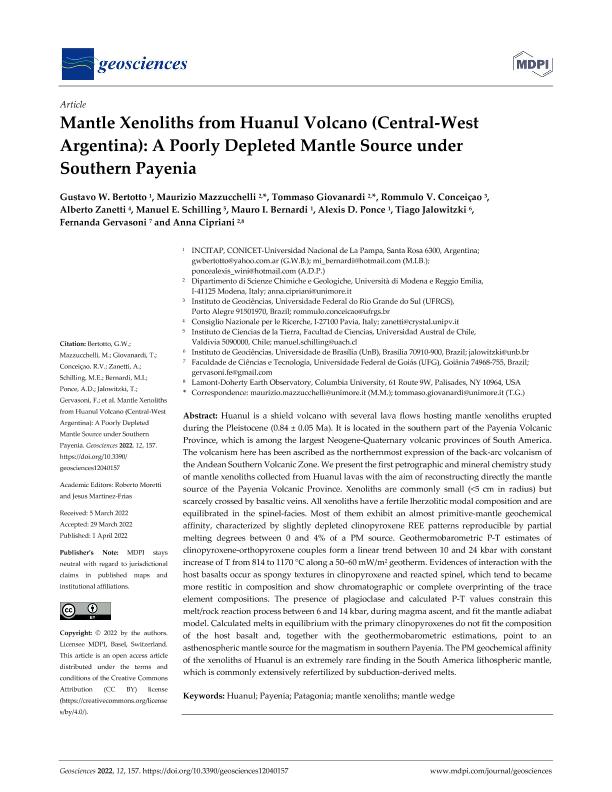Mostrar el registro sencillo del ítem
dc.contributor.author
Bertotto, Gustavo Walter

dc.contributor.author
Mazzucchelli, Maurizio

dc.contributor.author
Giovanardi, Tommaso

dc.contributor.author
Conceiçao, Rommulo V.
dc.contributor.author
Zanetti, Alberto
dc.contributor.author
Schilling, Manuel E.
dc.contributor.author
Bernardi, Mauro Ignacio

dc.contributor.author
Ponce, Alexis Daniel

dc.contributor.author
Jalowitzki, Tiago
dc.contributor.author
Gervasoni, Fernanda
dc.contributor.author
Cipriani, Anna
dc.date.available
2023-09-27T15:36:03Z
dc.date.issued
2022-04
dc.identifier.citation
Bertotto, Gustavo Walter; Mazzucchelli, Maurizio; Giovanardi, Tommaso; Conceiçao, Rommulo V.; Zanetti, Alberto; et al.; Mantle Xenoliths from Huanul Volcano (Central-West Argentina): A Poorly Depleted Mantle Source under Southern Payenia; MDPI; Geosciences; 12; 4; 4-2022; 1-23
dc.identifier.issn
2076-3263
dc.identifier.uri
http://hdl.handle.net/11336/213257
dc.description.abstract
Huanul is a shield volcano with several lava flows hosting mantle xenoliths erupted during the Pleistocene (0.84 ± 0.05 Ma). It is located in the southern part of the Payenia Volcanic Province, which is among the largest Neogene-Quaternary volcanic provinces of South America. The volcanism here has been ascribed as the northernmost expression of the back-arc volcanism of the Andean Southern Volcanic Zone. We present the first petrographic and mineral chemistry study of mantle xenoliths collected from Huanul lavas with the aim of reconstructing directly the mantle source of the Payenia Volcanic Province. Xenoliths are commonly small (<5 cm in radius) but scarcely crossed by basaltic veins. All xenoliths have a fertile lherzolitic modal composition and are equilibrated in the spinel-facies. Most of them exhibit an almost primitive-mantle geochemical affinity, characterized by slightly depleted clinopyroxene REE patterns reproducible by partial melting degrees between 0 and 4% of a PM source. Geothermobarometric P-T estimates of clinopyroxene-orthopyroxene couples form a linear trend between 10 and 24 kbar with constant increase of T from 814 to 1170 °C along a 50–60 mW/m2 geotherm. Evidences of interaction with the host basalts occur as spongy textures in clinopyroxene and reacted spinel, which tend to became more restitic in composition and show chromatographic or complete overprinting of the trace element compositions. The presence of plagioclase and calculated P-T values constrain this melt/rock reaction process between 6 and 14 kbar, during magma ascent, and fit the mantle adiabat model. Calculated melts in equilibrium with the primary clinopyroxenes do not fit the composition of the host basalt and, together with the geothermobarometric estimations, point to an asthenospheric mantle source for the magmatism in southern Payenia. The PM geochemical affinity of the xenoliths of Huanul is an extremely rare finding in the South America lithospheric mantle, which is commonly extensively refertilized by subduction-derived melts.
dc.format
application/pdf
dc.language.iso
eng
dc.publisher
MDPI
dc.rights
info:eu-repo/semantics/openAccess
dc.rights.uri
https://creativecommons.org/licenses/by/2.5/ar/
dc.subject
HUANUL
dc.subject
MANTLE WEDGE
dc.subject
MANTLE XENOLITHS
dc.subject
PATAGONIA
dc.subject
PAYENIA
dc.subject.classification
Geología

dc.subject.classification
Ciencias de la Tierra y relacionadas con el Medio Ambiente

dc.subject.classification
CIENCIAS NATURALES Y EXACTAS

dc.title
Mantle Xenoliths from Huanul Volcano (Central-West Argentina): A Poorly Depleted Mantle Source under Southern Payenia
dc.type
info:eu-repo/semantics/article
dc.type
info:ar-repo/semantics/artículo
dc.type
info:eu-repo/semantics/publishedVersion
dc.date.updated
2023-07-05T15:29:20Z
dc.journal.volume
12
dc.journal.number
4
dc.journal.pagination
1-23
dc.journal.pais
Suiza

dc.journal.ciudad
Basel
dc.description.fil
Fil: Bertotto, Gustavo Walter. Consejo Nacional de Investigaciones Científicas y Técnicas. Instituto de Ciencias de la Tierra y Ambientales de La Pampa. Universidad Nacional de La Pampa. Facultad de Ciencias Exactas y Naturales. Instituto de Ciencias de la Tierra y Ambientales de La Pampa; Argentina
dc.description.fil
Fil: Mazzucchelli, Maurizio. Università di Modena e Reggio Emilia; Italia
dc.description.fil
Fil: Giovanardi, Tommaso. Università di Modena e Reggio Emilia; Italia
dc.description.fil
Fil: Conceiçao, Rommulo V.. Universidade Federal do Rio Grande do Sul; Brasil
dc.description.fil
Fil: Zanetti, Alberto. Centre National de la Recherche Scientifique; Francia
dc.description.fil
Fil: Schilling, Manuel E.. Universidad Austral de Chile; Chile
dc.description.fil
Fil: Bernardi, Mauro Ignacio. Consejo Nacional de Investigaciones Científicas y Técnicas. Instituto de Ciencias de la Tierra y Ambientales de La Pampa. Universidad Nacional de La Pampa. Facultad de Ciencias Exactas y Naturales. Instituto de Ciencias de la Tierra y Ambientales de La Pampa; Argentina
dc.description.fil
Fil: Ponce, Alexis Daniel. Consejo Nacional de Investigaciones Científicas y Técnicas. Instituto de Ciencias de la Tierra y Ambientales de La Pampa. Universidad Nacional de La Pampa. Facultad de Ciencias Exactas y Naturales. Instituto de Ciencias de la Tierra y Ambientales de La Pampa; Argentina
dc.description.fil
Fil: Jalowitzki, Tiago. Universidade do Brasília; Brasil
dc.description.fil
Fil: Gervasoni, Fernanda. Universidade Federal de Goiás; Brasil
dc.description.fil
Fil: Cipriani, Anna. Università di Modena e Reggio Emilia; Italia
dc.journal.title
Geosciences
dc.relation.alternativeid
info:eu-repo/semantics/altIdentifier/url/https://www.mdpi.com/2076-3263/12/4/157
dc.relation.alternativeid
info:eu-repo/semantics/altIdentifier/doi/http://dx.doi.org/10.3390/geosciences12040157
Archivos asociados
